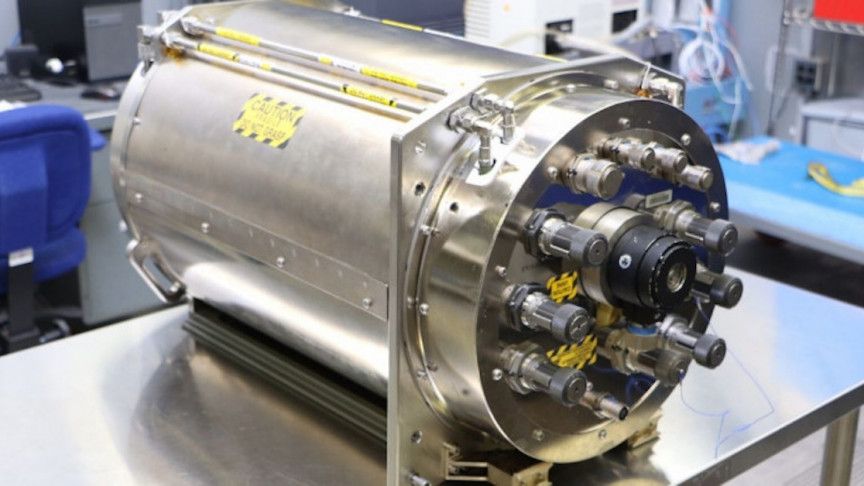Page 5869
Dec 16, 2020
To do in 2021: Get up to speed with quantum computing 101
Posted by Saúl Morales Rodriguéz in categories: business, computing, quantum physics
The first step is to understand qubits and superposition. The next one is to get a handle on the business advantage that this technology represents.
If “figure out quantum computing” is still in your future file, it’s time to update your timeline. The industry is nearing the end of the early adopter phase, according to one expert, and the time is now to get up to speed.
Denise Ruffner, the vice president of business development at IonQ, said that quantum computing is evolving much faster than many people realize.
Dec 16, 2020
Team’s bigger and better ‘tweezer clock’ is super stable
Posted by Saúl Morales Rodriguéz in categories: particle physics, quantum physics
JILA physicists have boosted the signal power of their atomic “tweezer clock” and measured its performance in part for the first time, demonstrating high stability close to the best of the latest generation of atomic clocks.
The unusual clock, which uses laser tweezers to trap, control and isolate atoms, offers unique possibilities for enhancing clock performance using the tricks of quantum physics as well as future applications in quantum information processing, quantum simulation, and measurement science.
Described in a Nature paper published online Dec. 16, the clock platform is a rectangular grid of about 150 strontium atoms confined individually by optical tweezers, which are created by a laser beam aimed through a microscope and deflected into 320 spots. This upgraded version of the clock has up to 30 times as many atoms as the preliminary design unveiled last year, due mainly to the use of several different lasers, including a green one for trapping the atoms and two red ones to make them “tick.”
The current scheme, Horizon 2020, is the world’s biggest multinational research programme, having distributed €74 billion (US$90 billion) to more than 150, 000 scientists participating in 31, 000 projects or grants. When it ends this year, how will it be judged?
Although imperfect, the world’s biggest funding scheme got a lot right.
Dec 16, 2020
Mass Extinctions Happen Every 27 Million Years
Posted by Quinn Sena in categories: existential risks, mathematics, robotics/AI
(Checks math.)
Scientists have new evidence that Earth’s many periodic mass extinctions follow a cycle of about 27 million years, connecting the five major mass extinctions with more minor ones occurring throughout Earth’s life-fostering timespan. The artificial intelligence analysis could also shift how evolutionary scientists think about the aftermath of mass extinctions.
Dec 16, 2020
Fermilab and partners achieve sustained, high-fidelity quantum teleportation
Posted by Quinn Sena in category: quantum physics
A joint team of researchers at Fermilab and partner institutions have achieved quantum teleportation, teleporting information over a distance of 44 kilometers. The remarkable achievement supports the premise that scientists and engineers can build a workable and high-fidelity quantum network using practical devices.
Dec 16, 2020
LiquidPiston’s “inside-out” rotary X-Engine wins Army research contract
Posted by Quinn Sena in categories: military, robotics/AI

Connecticut-based company LiquidPiston is developing a portable generator for the US Army that uses its X-Engine, a fresh and extremely powerful take on the rotary engine that’ll deliver as much power as the Army’s current-gen-set at one-fifth the size.
We’ve written a few times before about the fascinating LiquidPiston rotary engine. It’s not a Wankel – indeed, it’s closer to an inside-out Wankel – and with only two moving parts, it’s able to deliver extraordinary power density at up to 1.5 horsepower per pound (0.45 kg).
Continue reading “LiquidPiston’s ‘inside-out’ rotary X-Engine wins Army research contract” »
Dec 16, 2020
The Air Force Just Let an AI Take Over Systems of a Military Jet
Posted by Brent Ellman in categories: military, robotics/AI
The flight marks the first known time an AI has to been used to control a US military aircraft.
“This is the first time this has ever happened,” assistant Air Force Secretary Will Roper told the newspaper.
The AI took care of some highly specific tasks and was never in control of actually flying the plane — or, notably, any weapon systems.
Dec 16, 2020
Giant pulses detected in the pulsar PSR J1047−6709
Posted by Quinn Sena in category: space
Using the Parkes radio telescope, Chinese astronomers have investigated an isolated pulsar known as PSR J1047−6709 and detected dozens of giant pulses during the bright state of this source. The finding is reported in a paper published December 10 on the arXiv pre-print repository.
Pulsars are highly magnetized, rotating neutron stars emitting a beam of electromagnetic radiation. They are usually detected in the form of short bursts of radio emission, however, some of them are also observed using optical, X-ray and gamma-ray telescopes. To date, most pulsars have been discovered using the Parkes Observatory in Australia.
Some pulsars showcase the so-called giant pulses (GPs)—short-duration, burst-like radio emissions from a pulsar, with energies exceeding the average pulse energy by 10 times or even much more. So far, such activity has only been detected in 16 pulsars.
Dec 16, 2020
Astronaut Urine Filter Could Soon Provide Drinking Water on Earth
Posted by Raphael Ramos in categories: space, sustainability
Aquaporin, the company that designed NASA’s wastewater filtration system, plans to use this technology on Earth and help with water scarcity. Discover now.

















